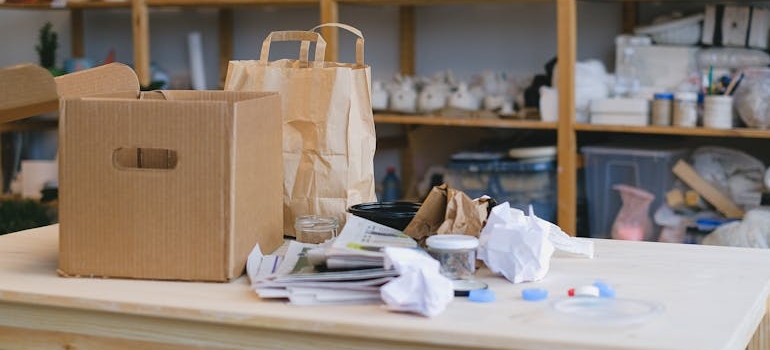How to Source Eco-Friendly Packing Materials
The demand for eco-friendly packing materials has never been greater. Both Seattle residents and businesses alike are seeking ways to reduce waste and adopt sustainable practices. Traditional packaging—often made of plastics and other non-biodegradable materials—contributes significantly to environmental pollution. Switching to sustainable materials is therefore more than a trend; it’s a necessity for a healthier planet. Hence, choosing eco-friendly options aligns with modern consumer expectations for responsible practices. So let’s explore practical solutions and actionable advice from the best movers and packers Seattle has for sourcing eco-friendly packing materials effectively.
Why Choose Eco-Friendly Packing Materials?
Making environmentally conscious decisions can elevate both personal and business practices. Adopting sustainable packing materials shows that you care about reducing waste and minimizing your ecological footprint. Today’s consumers prefer brands that demonstrate responsibility, and choosing sustainable packaging aligns with those values.
Imagine using sturdy fabric wraps for shipments instead of disposable plastic. Not only do they look professional, but they can also be repurposed multiple times, cutting costs while reducing waste. Your choice today can help shape a better tomorrow.

Common Types of Eco-Friendly Packing Materials
Sourcing the right materials doesn’t have to be overwhelming. Sustainable options are versatile and cater to various needs, from shipping fragile items with Seattle shipping companies to protecting bulkier goods.
Biodegradable Materials
Materials like cornstarch-based plastics and mushroom packaging are gaining popularity. These innovative options break down naturally without leaving harmful residues. They work particularly well for food packaging or protective inserts for fragile items.
Recyclable Options
Cardboard boxes, kraft paper, and recyclable bubble wrap are widely available and affordable. They offer the same level of protection as traditional materials while being much easier to recycle. Opt for unbleached or minimal-ink versions to ensure maximum recyclability.
Reusable Solutions
Items like cloth wraps, metal tins, or wooden crates offer durability and appeal. Reusable options not only save resources but also provide a premium feel. Consider incorporating reusable designs into your branding to encourage long-term customer engagement.
Compostable Alternatives
Compostable materials like plant-based packing peanuts dissolve in water or biodegrade in compost piles. These are perfect for businesses looking to leave a zero-waste impression. With so many options, you can select materials tailored to your specific needs while reducing your environmental impact.
Where to Source Eco-Friendly Packing Materials
Identifying reliable sources for eco-friendly materials ensures consistency and quality. Taking time to research moving boxes Seattle suppliers can lead to cost savings and sustainable outcomes.
- Specialized Eco-Packaging Suppliers: Many companies specialize in sustainable materials. Look for suppliers that provide detailed information about their products, including certifications or manufacturing processes. Brands like EcoEnclose and Packhelp offer a range of customizable, eco-conscious options.
- Local Businesses and Small Vendors: Supporting local suppliers not only strengthens your community but also reduces transportation emissions. Reach out to nearby businesses, farmer’s markets, or cooperatives to explore sustainable packaging solutions.
- Online Platforms: Marketplaces such as Etsy and specialized e-commerce sites often feature small-scale sellers focused on sustainability. Always verify claims of eco-friendliness by checking certifications or customer reviews.
- Creative DIY Solutions: Many eco-friendly materials can be created from items already available at home. Old newspapers, shredded cardboard, or scrap fabrics can serve as excellent packing solutions. If you enjoy hands-on approaches, this can be both cost-effective and rewarding.
Sourcing the right materials is about balancing sustainability, affordability, and quality. Tailoring your approach to match your goals makes the process more efficient.
Certifications and Standards to Look For
Understanding certifications can help you identify truly sustainable materials. Not all eco-friendly claims are created equal, so it’s crucial to look for credible labels that guarantee quality and authenticity.
FSC Certification (Forest Stewardship Council)
Products with FSC (Forest Stewardship Council) certification ensure that materials come from responsibly managed forests that prioritize ecological balance, biodiversity, and the rights of local communities. FSC-labeled cardboard or paper products are commonly used in packaging, shipping, and office supplies. They serve as excellent choices for businesses and households seeking sustainable alternatives to traditional materials.
Green Seal
This label signifies that the product meets rigorous sustainability standards, covering aspects like material sourcing and manufacturing processes. Green Seal-certified items are widely recognized as trustworthy.
Cradle-to-Cradle Certification
Products with this certification are designed to be reused or recycled at the end of their life. It’s a sign of a company committed to long-term sustainability. Certifications provide peace of mind and ensure you’re not unknowingly contributing to environmental harm. When sourcing packing materials from your chosen local movers in Seattle, always prioritize items with transparent labeling and credible endorsements.

Cost Considerations and Budget-Friendly Strategies
Sustainable packaging doesn’t have to be expensive. While some materials may have higher upfront costs, creative strategies can help you make eco-friendly choices without straining your budget.
Compare prices across suppliers to find competitive rates. Bulk purchasing often leads to discounts, making eco-friendly options more affordable over time. If you’re running a business, consider collaborating with other companies in your area to share costs for sustainable supplies.
Explore government grants or incentives available for adopting sustainable practices. Many regions offer subsidies to encourage businesses to reduce waste. Additionally, encouraging customers to return reusable packaging—like cloth bags or durable containers—can cut costs and foster brand loyalty.
Adopting eco-friendly materials is an investment in both the environment and your long-term savings. Prioritizing smart sourcing and collaboration ensures a smoother, more cost-effective transition.
Challenges in Adopting Eco-Friendly Packing Materials
Switching to sustainable packing materials can feel challenging, especially when dealing with unfamiliar options. However, identifying potential obstacles in advance makes the process manageable.
Availability varies depending on location. Some regions have limited access to eco-friendly suppliers, making it necessary to rely on online options. Shipping sustainable materials may reduce local waste but increase emissions. To address this, look for suppliers offering regional production or warehouses closer to your area.
Initial costs may appear higher than traditional materials. However, focusing on long-term savings offsets this concern. Reusable or recyclable materials reduce recurring expenses, particularly for frequent packers or businesses.
Educating others on proper disposal methods requires effort. Misusing even the most eco-friendly materials negates their benefits. When choosing compostable options, include clear instructions for proper handling. Providing this information ensures materials reach their intended end-of-life destination.
Facing these challenges with practical strategies simplifies the transition. Proactive planning and consultations with your Washington movers ensure your efforts benefit the planet without becoming overwhelming.

Tips for Successfully Transitioning to Eco-Friendly Packing Materials
Transitioning to sustainable packaging requires thoughtful steps to ensure success. A well-organized approach allows you to make significant changes without disrupting your process.
Start with a packaging audit. Evaluate current materials and identify wasteful practices. Highlight areas where eco-friendly alternatives can replace less sustainable options. Small changes, like swapping plastic fillers for shredded paper, create a noticeable impact.
Adopt a phased approach. Begin by integrating a few sustainable materials and expand gradually. This prevents waste of existing supplies and eases the learning curve. Testing new materials in smaller quantities identifies what works best for your needs.
Engage others in the transition, too. If you run a business, involve your team by offering training on sustainable practices. Encourage customers or partners to support eco-friendly initiatives by sharing benefits and providing incentives.
Offer feedback to suppliers. Many eco-friendly companies value input, and your suggestions can lead to better products. Sharing your experience also strengthens relationships with vendors, ensuring consistent quality. Taking these steps ensures your move toward sustainability is effective and practical. Focus on gradual progress to build lasting habits that benefit the environment.
Future Trends in Sustainable Packaging
Staying ahead of trends in sustainable packaging helps you adopt innovative solutions. Advances in materials and technology continue to expand the possibilities for eco-friendly packing.
Biodegradable plastics are evolving rapidly. New options, derived from seaweed, algae, and agricultural waste, offer improved strength and versatility. These materials provide durable alternatives without the environmental harm associated with traditional plastics.
Smart packaging technologies are merging sustainability with functionality. Embedded QR codes or sensors track product conditions, enhancing efficiency while reducing excess materials. Companies are also exploring plant-based inks and adhesives to improve recyclability.
Minimalist designs prioritize function over form. Reducing unnecessary layers or decorative elements decreases waste without compromising quality. Many brands now incorporate multipurpose packaging, where containers serve a secondary use, encouraging reuse.
Expect regulations favoring sustainable materials to grow. Governments worldwide are implementing stricter rules on single-use plastics and waste management. Adopting eco-friendly options now ensures compliance with future standards. Embracing these trends positions you as a leader in sustainable practices. Watching industry developments allows you to make informed decisions that align with future goals.

Practical Examples of Sourcing Eco-Friendly Packing Materials
Learning from others’ successes provides inspiration and practical guidance. Many organizations and everyday packers have achieved significant results by prioritizing sustainability.
A local Seattle business can reduce shipping costs by switching to recycled cardboard boxes and plant-based fillers. Customers will appreciate the eco-friendly effort, which boosts brand loyalty. The change also results in lower disposal fees, saving money over time.
Another example comes from those who frequently relocate with moving services Seattle offers. Instead of relying on single-use materials, sturdy plastic totes and reusable fabric wraps can be the go-to choice. These items survived multiple moves, eliminating waste and saving storage space between uses.
Creative upcycling also inspires change. Old T-shirts were turned into padding for fragile items, while newspapers served as wrapping. These solutions reduced expenses and added a personal touch. Stories like these demonstrate the impact of sustainable decisions. You can replicate these practices by tailoring them to your needs, ensuring both practicality and environmental benefits.
How to Engage Others in Sustainability Efforts
Your commitment to sustainable packing materials can influence others to make similar choices. Encourage friends, family, or colleagues to adopt eco-friendly practices and multiply the positive impact.
Share your journey through social media or community groups. Highlight the materials you use and explain their benefits. Include tips for sourcing affordable options or using DIY alternatives. Clear and relatable examples inspire others to act.
Collaborate with local organizations or businesses. Hosting workshops on eco-friendly packaging techniques spreads awareness and builds connections. This outreach often leads to discovering new resources and opportunities.
Provide incentives for others to join your efforts. Businesses might offer discounts for returning reusable packaging or rewards for eco-conscious practices. At home, encourage creative ideas for upcycling or repurposing materials, making sustainability a shared project.
Your leadership sets an example. Others look to you for practical advice, and your actions demonstrate the ease and benefits of eco-friendly choices. Together, these efforts drive broader change.

Recap and Action Plan
Making the shift to eco-friendly packing materials is a practical way to reduce waste and contribute to a healthier planet. You now have actionable steps to source, use, and promote sustainable materials effectively.
Evaluate your current packing habits and identify areas for improvement. Explore available materials, considering factors like cost, accessibility, and purpose. Start small and expand your efforts over time, focusing on gradual progress. Engage suppliers who prioritize sustainability and look for certifications that guarantee eco-friendly claims. Incorporate feedback from your experiences to improve your approach and share insights with others.
Stay informed about future trends and advancements in packaging materials. Adopting innovative solutions ensures you remain at the forefront of sustainability. Encouraging those around you to join your efforts amplifies the positive impact. The transition to eco-friendly materials may seem daunting, but each step you take has a lasting effect. Begin today, and your choices will benefit the planet for years to come.
Why Choose Us
History
Hansen Bros. Moving & Storage is locally owned and operated by the same family for four generations, since 1890. We have a well-established reputation for service quality and reliability with a high percentage of repeat household and commercial clients.
Professionalism
We’re a certified ProMover by the American Moving and Storage Association with A+ rating with the Better Business Bureau, voted “Best in Western Washington” in 2009 and from 2011 to 2016 by KING5. Our company is fully licensed and insured and member of WMC and AMSA.
Value
Hansen Bros. Moving & Storage provide free, no-obligation in-home estimate and competitive rates, including low minimum rates for shipments moving under 300 miles. We’ve set a refund policy for unused packing materials and three Puget Sound locations to help clients save on travel fee costs.



